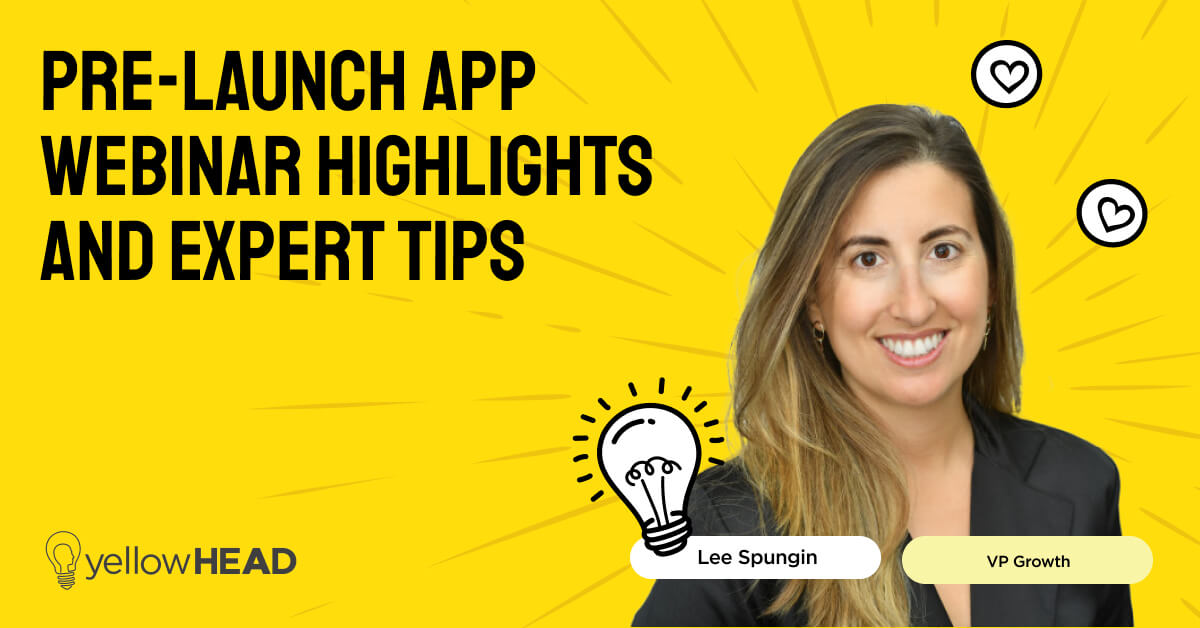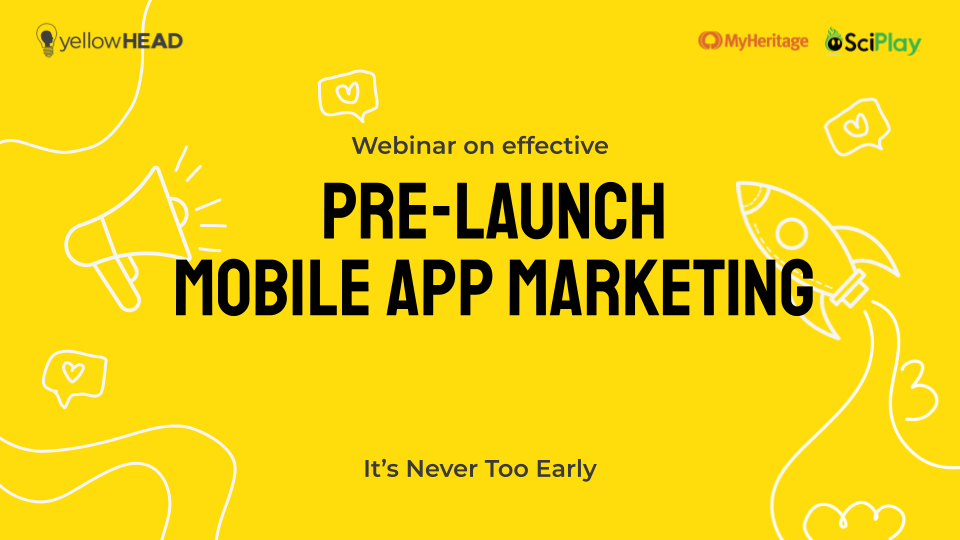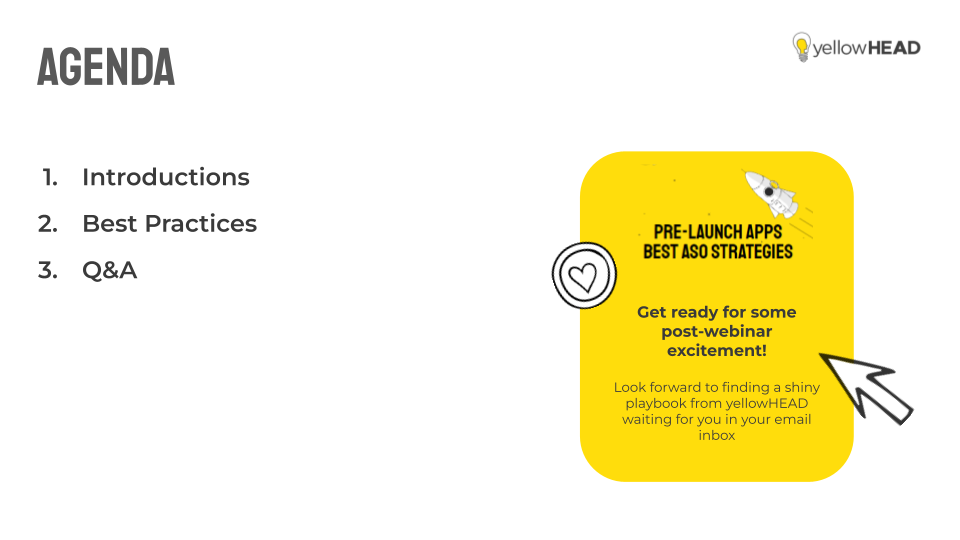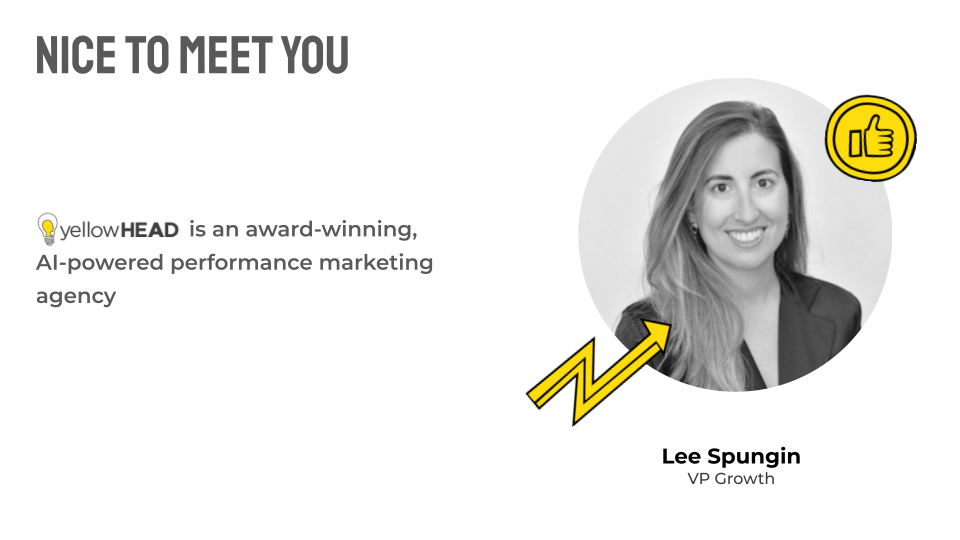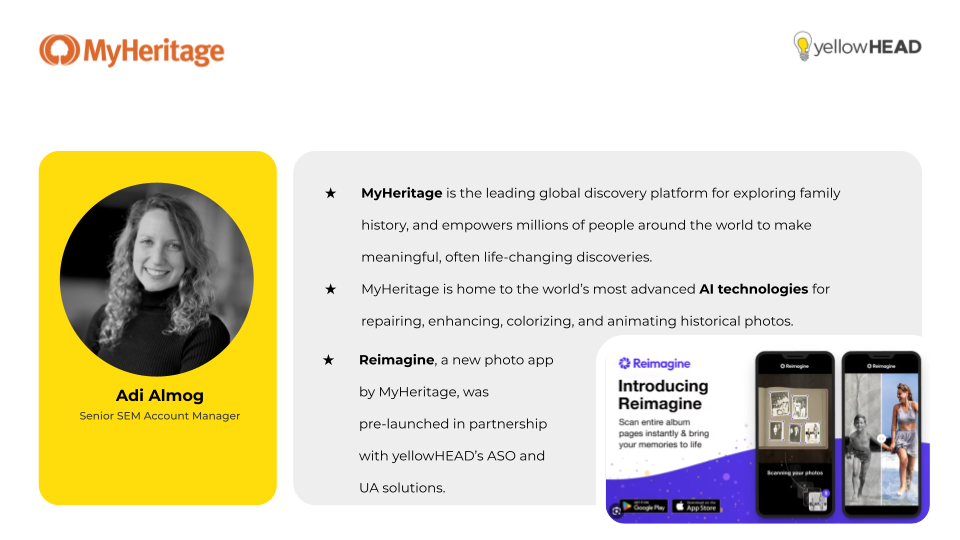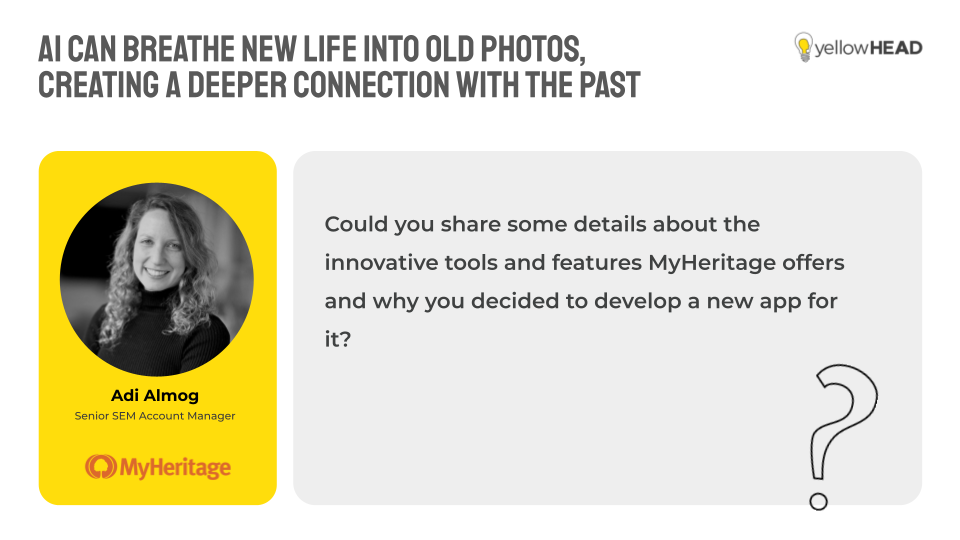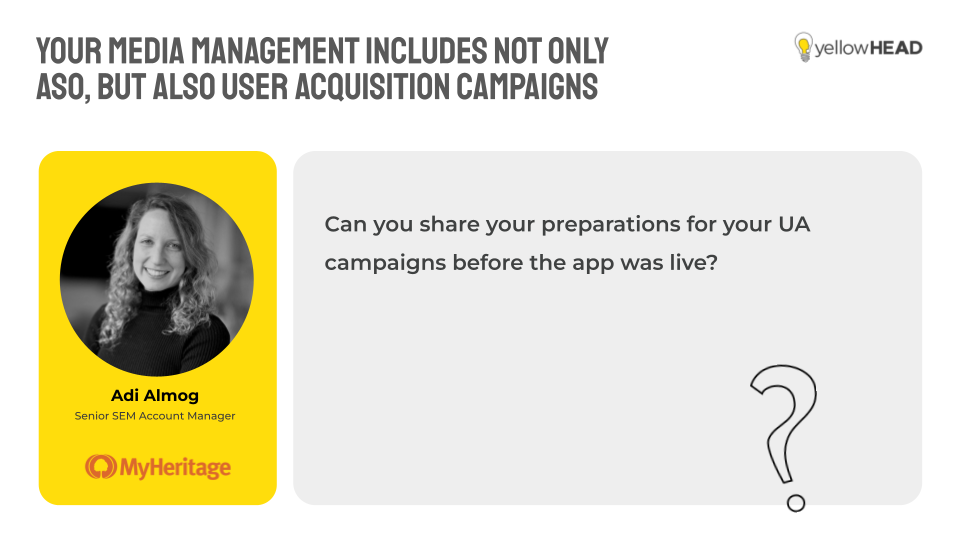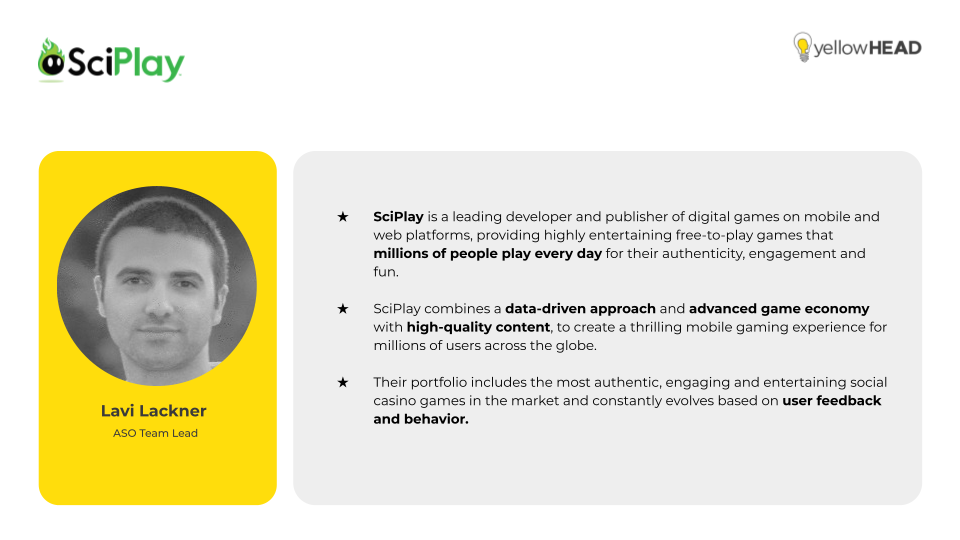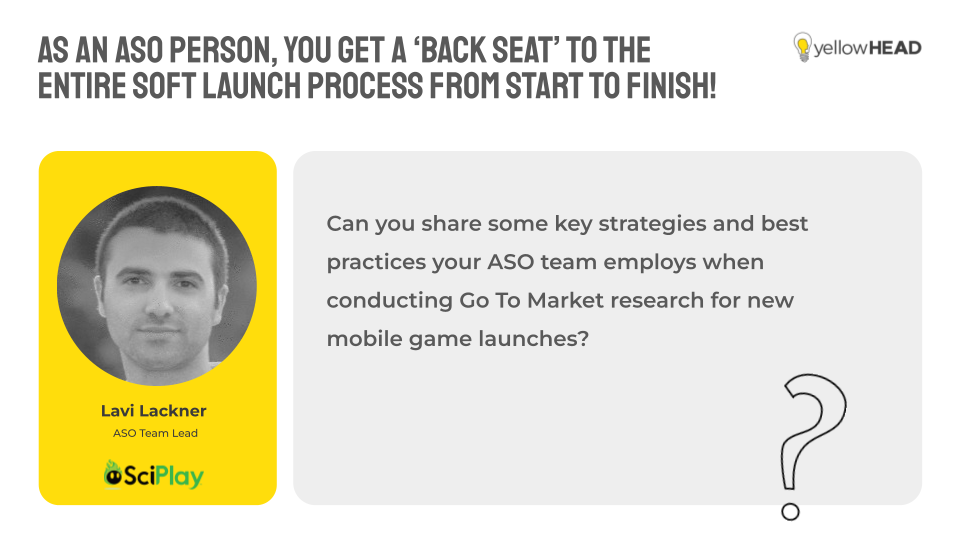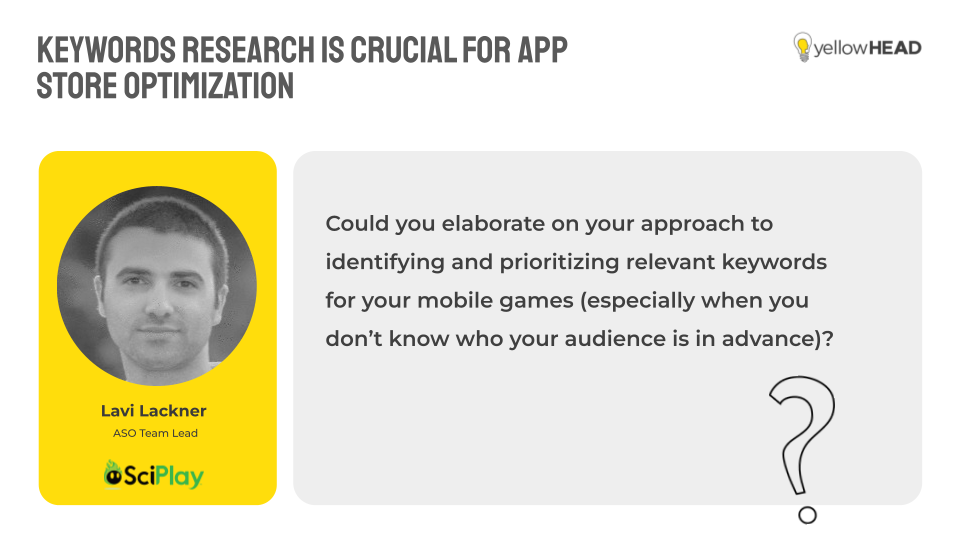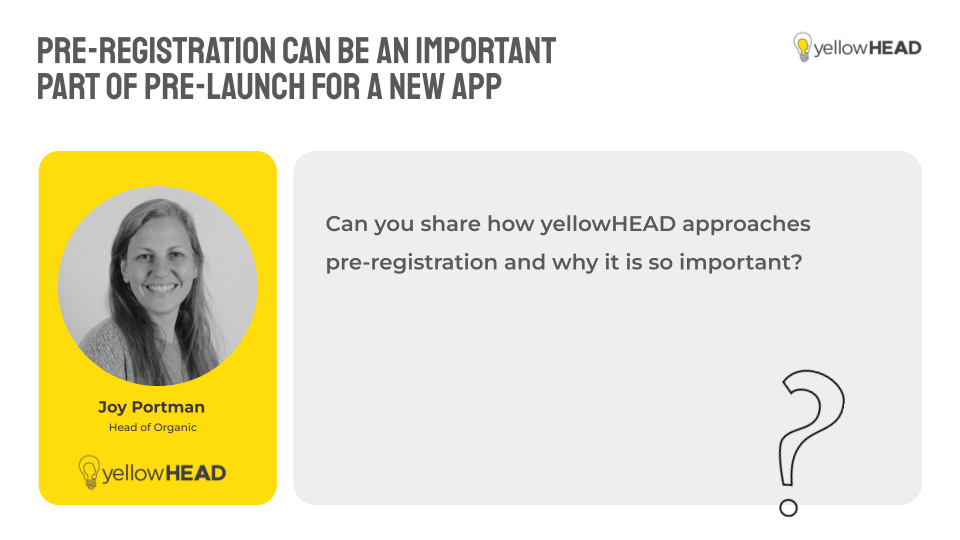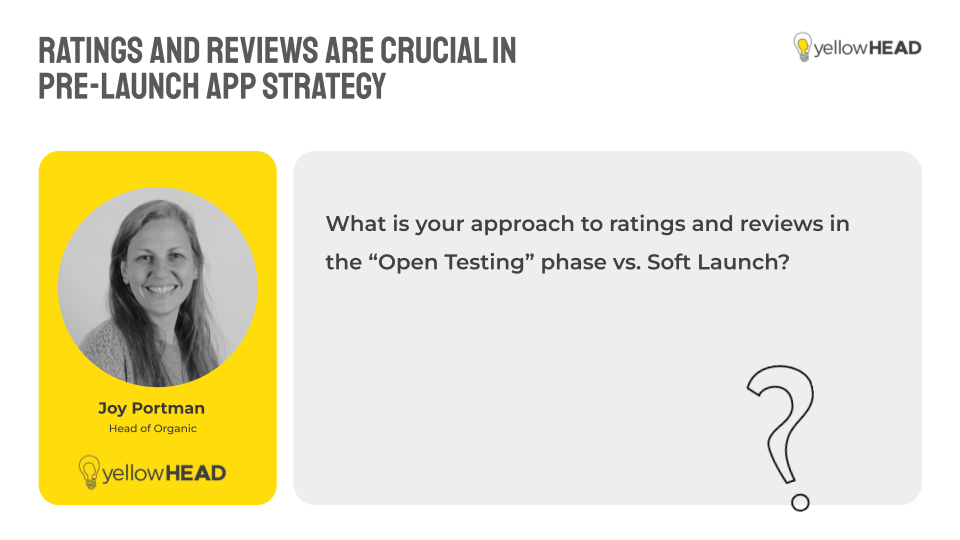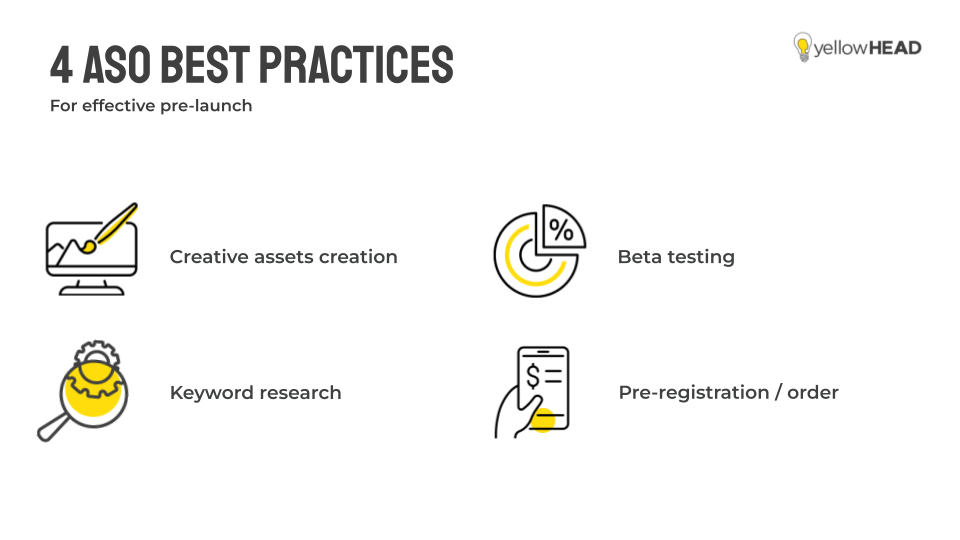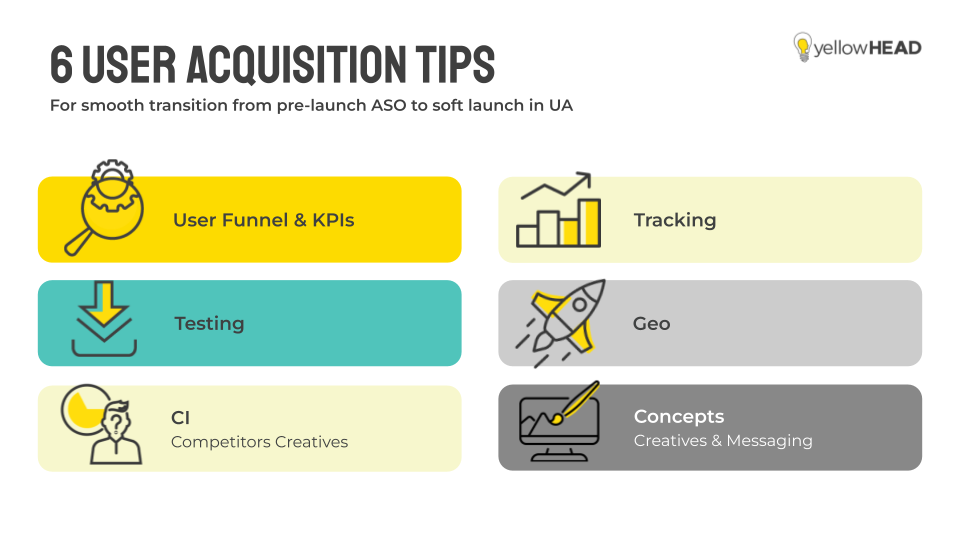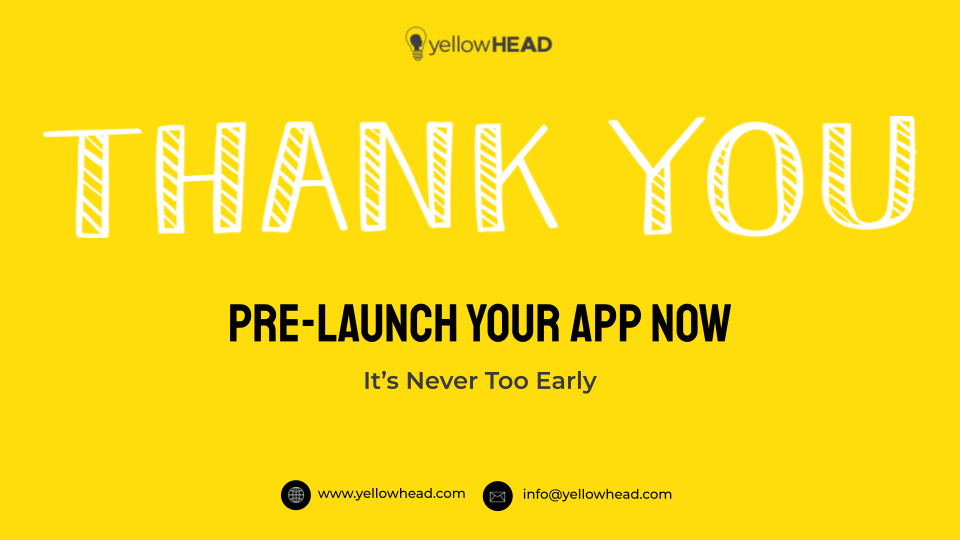Pre-launch App Webinar Highlights and Expert Tips
Join us for an exclusive recap of our dynamic live online webinar, which took place on April 3rd, 2024. We were privileged to be joined by esteemed experts from SciPlay, MyHeritage, and the renowned yellowHEAD. As the host of this insightful session, I am thrilled to provide you with a glimpse into the highlights and invaluable expert insights shared during the event.
You’ve poured your heart and soul into crafting an exceptional app, and now you’re eager to unveil it to the world. That’s precisely why we organized this webinar—to guide you through the exciting journey of launching your masterpiece to the global stage.
The agenda of the webinar:
To receive a copy of the playbook distributed to webinar attendees, kindly reach out to us via email at [email protected]. We’ll gladly send you a copy straight to your inbox.
I’m Lee, your host for today’s webinar. As the Vice President of Growth at yellowHEAD, I’m thrilled to be guiding you through our discussion. For those who may be new to yellowHEAD, allow me to introduce us: We’re an award-winning AI-powered performance marketing agency, dedicated to driving success and innovation in the digital realm.
Allow me to introduce our esteemed panellists joining us today. First, we have Adi Almog from MyHeritage, bringing her expertise as a Senior SCM Account Manager. Next, I’m delighted to introduce Joy Portman, my esteemed colleague and Head of Organic at yellowHEAD. And last but not least, we eagerly await the insights of Lavi Lackner, ASO Team Lead at Sciplay.
Adi Almog: During my four-year tenure at MyHeritage, I’ve served as a Senior SEO and Account Manager, primarily overseeing our paid search activities. At MyHeritage, we specialize in genealogy, providing users with the tools to build and explore their family trees online, uncovering new insights into their family history.
Around a year ago, we embarked on an exciting journey to develop a new app, a reimagination of our services. I had the privilege of spearheading the marketing endeavors for this project.
Adi Almog, MyHeritage: “In this endeavor, yellowHEAD became a valuable partner, assisting us in our ASO efforts and bolstering our user acquisition campaigns. I’m grateful for the opportunity to collaborate with such talented professionals.”
Adi Almog: Let me walk you through the evolution of MyHeritage, where our focus has shifted toward harnessing advanced AI technology to revolutionize how users interact with their family history. Our mission is simple yet profound: to empower our users to preserve, manage, and breathe new life into their cherished family photos.
Among our array of innovative features is colorization, which transforms black and white photos into vibrant, lifelike images. We also offer tools to repair damaged photos, restore faded colors, enhance blurry images, and even animate photos, imbuing them with a captivating sense of life and nostalgia. Imagine seeing your ancestors’ photos come to life, smiling back at you—it’s an emotionally resonant experience that truly sets us apart.
Additionally, our photo scanner feature simplifies the process of digitizing entire album pages with just a few taps. Our AI technology intelligently recognizes and crops individual photos within album pages, seamlessly preserving them in digital format within your photo gallery.
Three years ago, the launch of Deep Nostalgia, our photo animation tool, took the world by storm, sparking widespread fascination and viral acclaim. The overwhelming response highlighted a significant shift in user interest—toward photo tools rather than solely genealogy.
Adi Almog, MyHeritage: “Recognizing this opportunity, we set out to create a dedicated app, Reimagine, serving as a comprehensive hub for all MyHeritage photo tools under one independent brand.”
This strategic move allows us to expand our reach and cater to a broader audience, paving the way for exciting new possibilities and growth in uncharted directions.
Adi Almog: In the lead-up to launching our user acquisition activities, our team undertook a series of pivotal steps to ensure a successful rollout. Central to our approach was a comprehensive analysis of the competitive landscape, allowing us to identify key players, dissect their strategies, and glean valuable insights into their creative approaches, target demographics, and preferred marketing channels. Leveraging resources such as Meta Ads Library, TikTok Ads Library, and Google’s Transparency Center proved invaluable in this regard, offering a consolidated view of our competitors’ creative assets and tactics.
Adi Almog, MyHeritage: “With insights in hand, our next focus was on crafting compelling creatives tailored to our target audience. Collaborating closely with yellowHEAD, we engaged in collaborative brainstorming sessions to develop diverse concepts and produce a range of static banners and videos optimized for various platforms and ad placements.”
Media planning was the next critical phase, wherein we set clear objectives and allocated budgets for the initial three-month period. Defining key performance indicators (KPIs), such as desired install numbers and acceptable cost per install (CPI), ensured alignment with our profitability goals. Deliberations around platform selection factored in considerations of cost versus user quality, leading us to prioritize iOS for its profitability despite its higher acquisition costs.
To capitalize on low-hanging fruit channels, we commenced our efforts with targeted campaigns on Apple Search Ads for iOS and Google UAC campaigns for Android. Subsequent expansions into TikTok and Facebook advertising further broadened our reach and engagement.
Of course, alongside our strategic maneuvers, meticulous attention to technical infrastructure was paramount. Ensuring robust tracking mechanisms, selecting appropriate conversion events, and implementing necessary adjustments for iOS app tracking all contributed to our ability to accurately gauge campaign performance and optimize accordingly.
In essence, our journey toward successful user acquisition entailed thorough competitor analysis, strategic planning, and precise execution. By meticulously attending to each step of the process, we positioned ourselves for optimal performance and growth in the dynamic mobile app marketplace.
Lavi Lackner: At ScyPlay, we’re renowned as a premier developer and publisher of social casino games, with our titles often gracing the top ranks of app store charts.
One of our crowning achievements is our flagship game, Jackpot Party Casino, which has proudly held the title of the number one slots game in the US for several consecutive years. Working alongside a talented team deeply entrenched in the intricacies of game launches and soft launches, I have the pleasure of providing ASO support to ensure our games reach their full potential.
Lavi Lackner: During the crucial go-to-market phase, typically spearheaded by specialists dedicated to strategic planning, ASO teams also play a pivotal role in shaping the early trajectory of a product launch. While the responsibility for go-to-market research may not exclusively lie with ASO personnel, their input at this juncture is invaluable. Stakeholders across the board seek assurance that messaging and creative assets destined for app stores will be finely optimized ahead of soft launch—a realm where ASO experts shine.
As an ASO professional, your contribution to the go-to-market strategy is multifaceted. You begin by leveraging tools like data AI to swiftly identify top competitors in terms of downloads and revenue. Understanding this competitive landscape serves as the foundation for crafting differentiated assets. For instance, your insights guide recommendations on icon design, ensuring it stands out amidst the clutter of search results and related games.
Moreover, analyzing competitors’ featured screenshots, videos, and localization efforts provides crucial insights into industry trends and user preferences. Delving into user feedback, both positive and negative, offers a goldmine of information for tailoring store listings to resonate with target audiences.
Beyond creative elements, ASO professionals are adept at providing estimations on install targets required to rank highly for competitive keywords. These insights, packaged as part of the go-to-market strategy, offer stakeholders a comprehensive view of the competitive landscape and actionable recommendations for maximizing visibility and engagement in the app marketplace.
Lavi Lackner, SciPlay: “In essence, ASO teams are integral players in the go-to-market journey, offering expertise that enriches strategic decision-making and ensures the optimal positioning of products for success.”
Lavi Lackner: It’s essential to emphasize that when embarking on the launch of a new game, understanding your target audience is paramount. Without a clear understanding of who your game is designed for, its success is compromised from the start. Leveraging tools like GameRefinery and similar platforms aids in mapping out player types, identifying key demographics, and discerning their motivations, thereby ensuring alignment between your game and its intended audience.
Building on this, effective go-to-market research not only unveils competitors but also serves as a rich source of potential keywords. By analyzing competitors’ metadata, descriptions, store creatives, and user reviews, valuable keyword insights emerge, laying the groundwork for strategic optimization efforts. ASO tools like AppTweak further streamline this process, offering AI-generated keyword suggestions, competitor keyword analysis, and category-specific insights.
Moreover, launching a game within the same genre as previous titles offers a distinct advantage. Leveraging insights from past successes enables you to target proven keywords effectively, streamlining the optimization process and maximizing visibility within your niche.
Prioritizing keywords within your game’s metadata involves a nuanced approach, balancing search scores and keyword difficulty to optimize visibility while minimizing competition. This strategic approach ensures that the most impactful keywords are strategically positioned within your title, description, and other metadata fields.
Lavi Lackner, SciPlay: “There’s a multitude of avenues for uncovering and prioritizing keywords during the initial drafting phase of your game’s listings. By leveraging a combination of competitor analysis, ASO tools, and genre-specific insights, you can craft optimized listings that resonate with your target audience and propel your game to success.”
Next up, we have Joy Portman, our esteemed Head of Organic at yellowHEAD. Given our collective familiarity with yellowHEAD from this and previous webinars, let’s forgo the introductory spiel about our company. Instead, we’re eager to dive straight into some insightful questions:
Joy Portman: Let’s delve into the intriguing realm of preregistration for Android and preorder for iOS—an often overlooked but strategically significant stage for both ASO and UA. But first, what exactly are preregistration and preorder?
These functionalities allow developers to have their product pages live on the store before the official app launch. Think of it as a teaser—a fully fleshed-out product page complete with icon, title, short description, subtitles, and even a creative. Once the app goes live, users who opted in for preregistration or preorder receive push notifications, and in some cases, the app may even be auto-installed on certain Android devices.
It’s worth noting the time constraints: Android offers a 90-day window for preregistration, while Apple extends this period to 180 days for preorder. Hence, careful consideration is essential when deciding the optimal timing to initiate this stage, considering the holistic perspective of product development, UA, and ASO.
Joy Portman, yellowHEAD: “Preregistration and preorder offer a plethora of benefits, starting with brand awareness. This stage allows you to generate buzz, build anticipation, and foster connections with your audience. It’s the perfect opportunity to kick-start social media campaigns, initiate email marketing efforts, and drive traffic to your website through external links.”
Moreover, launching with preregistration or preorder means you hit the ground running on day one. With a bank of future installs awaiting activation, you’re not starting from scratch. This initial surge in installs, combined with proactive ASO efforts, sets the stage for a robust app launch.
From an ASO standpoint, the benefits are manifold. Keywords begin to be indexed, enabling your app to rank for both branded and non-branded terms—even before it’s available for download. This early indexing enhances visibility and cultivates familiarity with your brand among potential users.
Furthermore, this stage offers an ideal testing ground for your keyword strategy. By analyzing keyword performance before the official launch, you can fine-tune your approach and optimize for maximum impact.
Going global? Preregistration and preorder also pave the way for localization efforts, ensuring that your store and keywords are tailored to diverse markets. Additionally, platforms like Google offer AB testing capabilities, allowing you to experiment with various creatives and messaging to optimize conversion rates.
Lastly, don’t overlook the opportunity to request a feature in Apple’s “Coming Soon” section—a prime spot for garnering early traffic and engagement before your app hits the virtual shelves.
In essence, preregistration and preorder represent more than just a placeholder—they’re a strategic springboard for building anticipation, driving installs, refining ASO strategies, and laying the groundwork for a successful app launch.
Joy Portman: In both stages—open testing and soft launch—users have the opportunity to leave reviews. However, there’s a crucial distinction: during open testing, ratings and reviews remain invisible to users, presenting a challenge for conversion rates as potential users are greeted with a blank slate of zero ratings and reviews. Understanding the significant impact ratings and reviews have on user trust and decision-making, we recognize the importance of closely monitoring feedback during this phase.
While users may not see the reviews, developers and ASO teams have access to them through console platforms, enabling meticulous analysis of feedback on a daily, weekly, and monthly basis. Reviews are meticulously categorized, pinpointing any product-related issues or technical glitches. By segmenting feedback by device, we gain insights into specific problems like ANRs or crashes, empowering developers to address issues effectively.
Joy Portman, yellowHEAD: “From an ASO perspective, user reviews serve as a goldmine of insights. We scrutinize user feedback to identify keywords used by our target audience, integrating them into our metadata to enhance discoverability. Moreover, understanding user preferences and favored features allows us to align our metadata with user expectations, ultimately optimizing conversion rates.”
During the soft launch phase, all reviews and ratings become visible to users, providing invaluable social proof for potential users. Here, we pay close attention to the tone and content of reviews, advising developers to respond thoughtfully and proactively. Our approach emphasizes addressing user concerns promptly and transparently, demonstrating our commitment to user satisfaction.
By acknowledging and resolving issues raised in reviews, developers can foster positive relationships with users, potentially leading to revised ratings and improved app perception. In essence, leveraging user feedback throughout the testing and launch phases is instrumental in refining the app experience and maximizing its potential for success.
Lee Spungin: Let’s delve into four essential ASO practices for effective pre-launch preparation. While a comprehensive guide awaits you in our playbook, we’re eager to spotlight these key strategies today—some of which have already been touched upon by our panelists, Adi, Lavi, and Joy, drawing from their wealth of experience.
- Firstly, creative asset creation takes center stage. Crafting compelling visuals such as the app icon, screenshots, preview video, and for Google Play Store, the feature graphic, is crucial. These assets serve as your app’s visual ambassadors, enticing potential users and setting the tone for their experience.
- Next, meticulous keyword research is paramount. It’s not just about selecting keywords—it’s about strategically integrating them into your metadata to maximize discoverability. Balancing high and low search volume terms ensures that your app is visible to the right audience, while also aligning with its features and functionalities.
- Beta testing emerges as a critical step in the pre-launch journey. Beyond ensuring a smooth user experience, beta testing helps uncover any lingering bugs or issues that could lead to negative reviews post-launch. By ironing out these wrinkles beforehand, you pave the way for a more seamless rollout.
- Lastly, leveraging preregistration or preorder capabilities offers a unique opportunity to build anticipation and engage with your audience ahead of the official launch. By establishing your presence in the App Store or Google Play Store well in advance, you can drum up excitement, encourage user sign-ups, and ensure that eager users are notified the moment your app goes live.
In essence, these four practices form the cornerstone of a well-rounded pre-launch ASO strategy, laying the groundwork for a successful app debut and setting the stage for sustained growth and engagement in the competitive app landscape.
Joy Portman: With our ASO and UA strategies firmly anchored in these four essential steps, meticulously planned and rigorously tested across various stages, we stand poised for the ultimate challenge—the real deal.
The groundwork has been laid, the strategies honed, and the preparations thorough. Now, it’s time to put our plans into action and embark on the next phase of our journey with confidence and determination.
Lee Spungin: Having delved into the crucial role of paid acquisition in the prelaunch phase, we’ve compiled six invaluable user acquisition tips from our esteemed UA team.
- First and foremost, it’s essential to grasp the intricacies of the user funnel and implement event tracking effectively. Define your KPIs, set clear goals, and ensure alignment across all facets of your acquisition strategy.
- Testing is paramount—craft a comprehensive testing plan, glean insights in the initial weeks, and leverage these learnings to fine-tune your approach before the official launch.
- Next, competitive intelligence (CI) takes center stage. Analyze competitor creatives rigorously, gaining a nuanced understanding of industry trends and platform nuances. Tailor your creatives accordingly, ensuring they stand out amidst the competition and resonate with your target audience.
- Tracking is non-negotiable—resolve any tracking issues prelaunch to ensure seamless monitoring of app performance.\
- Choose your prelaunch geo strategically, gathering valuable insights to inform future activities.
- Crafting cohesive messaging that tells a compelling story from UA to app store is pivotal, enhancing user comprehension and engagement.
For those eager to delve deeper into UA strategies, I invite you to connect with me post-webinar. I’m enthusiastic about exploring further insights and strategies tailored to your specific needs. Let’s elevate your UA efforts together!
1. How do you build anticipation and excitement leading up to a launch date?
Lavi Lackner: The approach to prelaunch strategies varies significantly from one company to another. While some opt to generate buzz by offering pre-registration for their game, not every company chooses this path.
For those diving straight into the soft launch phase, the focus shifts to gradually scaling up UA campaigns to garner recognition for the game. Organic growth often follows suit, complementing the momentum gained through UA efforts. Additionally, maximizing visibility in the app store—whether through live ops, curated content, or feature placements—is key to generating buzz.
Building a dedicated community page around the game can further amplify its presence and engagement. While pre-registration or pre-order phases offer undeniable advantages in terms of building a user base pre-launch, not all companies opt for this route.
Regardless of the chosen strategy, fostering virality is essential. Leveraging various avenues—from social media engagement to word-of-mouth referrals—can propel the game into the spotlight and cultivate anticipation among potential players. Ultimately, the goal remains the same: to captivate audiences and pave the way for a successful game launch.
2. What steps did you take leading up to the launch of your app?
Adi Almog: As I mentioned earlier, our efforts toward the launch extended beyond ASO and UA campaigns, given that we were establishing a brand from scratch. From a holistic perspective, we delved into various marketing initiatives to solidify our presence in the market.
We strategically established organic social channels, including Facebook, TikTok, Instagram, YouTube, and Pinterest, where we curated and shared engaging content. This content ranged from informative how-to videos showcasing each feature of the app to create an impression of an established brand with a longstanding presence.
In addition, we orchestrated PR publications targeted at relevant markets, leveraging platforms like the MyHeritage blog to disseminate information about our new app, Reimagine. Furthermore, we initiated an email campaign targeting existing MyHeritage users, inviting them to explore and download our new offering. This not only served to generate initial traction but also provided an opportunity to iron out any unforeseen bugs before launching paid activities.
These supplementary endeavors were instrumental in bolstering our brand identity and establishing credibility within our target audience. Now, I’d like to pose a question to each of you, as I believe it’s pertinent to your respective areas of expertise.
3. Are there any emerging trends or innovative techniques in pre-launch mobile app marketing that we should be aware of?
Joy Portman :At this stage, maintaining a cohesive message across all channels is paramount. We’re dealing with users who are unfamiliar with our brand, encountering a new app with limited ratings, reviews, and installs. Building brand awareness and instilling trust in these users is our primary objective.
Creating synergy in messaging is crucial, regardless of whether users are directed from UA campaigns or our website. Consistency in messaging ensures a seamless transition for users from initial interaction to conversion in the app store. Whether they encounter our app through ASO efforts for non-branded terms or stumble upon it in paid campaigns, our messaging must resonate and reassure users of our credibility and value proposition.
In essence, harmonizing our messaging throughout the funnel is essential to cultivating trust and driving conversions in these early stages of app promotion.
Lavi Lackner: Certainly, I’d like to contribute a perspective from a slightly different angle to our discussion. While it’s not necessarily a trendy topic, it’s crucial for app developers to be cognizant of a notable shift in the soft launch landscape. Traditionally, it was common practice to swiftly expand into worldwide or tier 1 countries during the soft launch phase.
However, we’ve observed a recent trend indicating that this process now tends to take longer for various reasons. It’s essential for developers embarking on new launches to anticipate this potential delay. Breaking into tier 1 countries may require more time and effort than before, which is a trend even established developers have recently encountered.
Understanding this industry-wide shift is vital. It’s important not to become disheartened if entry into these prime markets doesn’t occur as swiftly as anticipated. Instead, adaptability and strategic planning are key to navigating this evolving landscape successfully.
4. When should I start the ASO? Only after the UA campaign starts or before?
Joy Portman: We firmly advocate for the establishment of a robust storefront to facilitate the conversion of paid acquisition users. Contrary to popular belief, this approach necessitates meticulous planning from the earliest stages.
Crafting a winning strategy involves diligent research into keywords, creative development, and thorough analysis of competitors’ apps. It’s imperative to build optimized storefronts tailored to your key markets, including tier one countries. By laying this groundwork beforehand, your UA and paid campaigns are poised for enhanced conversion rates.
In essence, prioritizing storefront optimization ensures that your investment in paid acquisition yields optimal results.
I extend my heartfelt gratitude to Lavi, Adi, and Joy for generously sharing their invaluable insights with us. Personally, I’ve gleaned a wealth of knowledge, and I’m confident our audience has too, despite my longstanding presence in the industry. I eagerly anticipate witnessing the fruition of these remarkable tips in the form of new, innovative apps hitting the market soon.
As mentioned earlier, don’t hesitate to reach out if you’d like to receive a copy of the playbook. Your feedback and engagement mean the world to us. Additionally, rest assured that a recording of this webinar is now available.
If you require ASO and UA support in your pre-launch, please feel free to contact yellowHEAD today.
